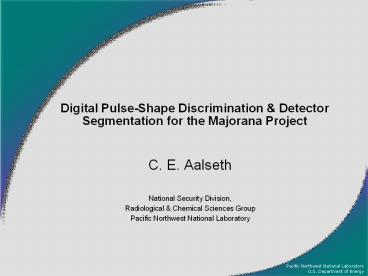Digital Pulse-Shape Discrimination PowerPoint PPT Presentation
Title: Digital Pulse-Shape Discrimination
1
Digital Pulse-Shape Discrimination Detector
Segmentation for the Majorana Project
- C. E. Aalseth
- National Security Division,
- Radiological Chemical Sciences Group
- Pacific Northwest National Laboratory
2
Majorana Overview(http//majorana.pnl.gov)
- 0nbb decay of 76Ge potentially measured at 2039
keV - Sensitive to effective Majorana n mass as low as
0.02-0.07 eV - Based on well-known 76Ge detector technology
plus - Pulse-shape analysis
- Detector segmentation
- Ready to begin now
- Requires
- Deep underground location
- 500 kg enriched 85 76Ge
- 210 crystals, 8 segments each
- Advanced signal processing
- Special materials (low bkg)
Baseline Concept
3
Physics Motivation for Background Rejection
- Interaction multiplicity varies with energy, type
of radiation - Multiple interactions change shape of induced
detector current
- Multi-site events
- Full-energy gamma signals gt500 keV
- Sum-energy peak signals
- Single-site events
- Gamma signals lt150 keV
- 72Ge(n, n e-) fast neutrons
- Double-escape peaks
- Internal beta-decay (no g) events
G. F. Knoll. Radiation detection and measurement.
John Wiley Sons, Inc., second edition, 1989.
4
Why Now is a good time for PSD.
- Commercial digital spectroscopy hardware is
available with fast (40 MHz), high-resolution
(14-bit) digitization - Significant developments in pulse-shape
discrimination techniques for HPGe have been made
in the past 10 years and are ready to apply to
new hardware
Full-energy 1621-keV g (top) and 1592-keV DEP
(bottom) reconstructed current pulses from 120
P-type Ortec HPGe detector (experimental data)
5
Starting Background Estimate
- International Germanium Experiment (IGEX)
achieved between 0.1-0.3 cts/keV/kg/y - Documented experiences with cosmic secondary
neutron production of isotopes
Calculated Experimental
6
Low-Background Electroformed CopperKey
Technologies
- Semiconductor-grade acids
- Glassware-free handling
- Copper sulfate purified by recrystallization
- Baths circulated with continuous microfiltration
to remove oxides and precipitates - Continuous barium scavenge removes radium
- Cover gas in plating tanks reduces oxide
formation - Periodic surface machining during production
minimizes dendritic growth
Low-background detector and electroformed
cryostat during assembly
7
Low-Background Electroformed Copper Examples
- Purity established with International Germanium
Experiment (IGEX) experience - Strength equal to OFHC
- Can be easily formed into thin, low-mass parts
- Parts shown are for the MEGA array
Electroformed cups shown have wall thickness of
only 250 mm!
8
Backgrounds 68Ge
9
Backgrounds 60Co
10
Single-site interaction example
Monte-Carlo 2038-keV deposition from 0n bb-decay
of 76Ge
11
Multiple-site interaction example
Monte-Carlo 2038-keV deposition from
multi-Compton of 2615-keV 208Tl g
12
PNNLMulti-parametric Discriminator
- Extracts key parameters from each preamplifier
output pulse - Sensitive to radial location of interactions and
interaction multiplicity - Self-calibrating allows optimal discrimination
for each detector - Discriminator can be recalibrated for changing
bias voltage or other variables - Method is computationally cheap, requiring no
computed libraries-of-pulses
13
PSD can reject multiple-site backgrounds (like
68Ge and 60Co)
Keeps 80 of the single-site DEP (double escape
peak)
Experimental Data
Rejects 74 of the multi-site backgrounds (use
212Bi peak as indicator)
Original spectrum
Scaled PSD result
Improves T1/2 limit by 56
14
Fast Neutron Signature
- Reaction of interest is 72Ge(n,ne-)
- Signature is single-site (electron nuclear
recoil) - Sensitive to useful range of fast-neutron energies
15
252Cf data result
- Result is virtually free of gamma interference
- Efficiency of PSD for the fast neutron signal is
91 - Fast neutron peak/continuum ratio improved by a
factor of 11 - Sensitivity increase of 300
total
Final result
16
Detector Segmentation
- Sensitive to axial and azimuthal separation of
depositions - Perkin-Elmer design with six azimuthal and two
axial contacts - Projected efficacy of this design is excellent
with expected backgrounds
17
Monte-Carlo Example
Segment multiplicity at 2039 keV
Sensitive to z and phi separation of depositions
0nbb efficiency 91 internal 60Co efficiency
14 Improves T1/2 limit by 140
18
(No Transcript)
19
Projected Sensitivity
- GIVEN
- Background at 2038 keV 0.2 cts/keV/kg/y
- 68Ge decay 10x reduction
- 60Co decay/self shielding/less copper mass 2x
reduction - 500 kg 86 76Ge x 10 years
- PSDSegmentation FOM 1.6 x 2.4 3.8
- RESULT
- 0n T½ 4.0 x 1027 y
- ltmngt 0.020 0.068 eV
20
Conclusions
- Unprecedented confluence
- Krasnoyarsk availability/Neutrino mass interest/
Underground development/Crystal capacity - High Density
- reduced shielding and footprint
- Low Risk
- proven technology / modular instrument /
relocatable - Experienced Collaboration
- long bb track record
- Neutrino mass sensitivity
- potential for discovery

